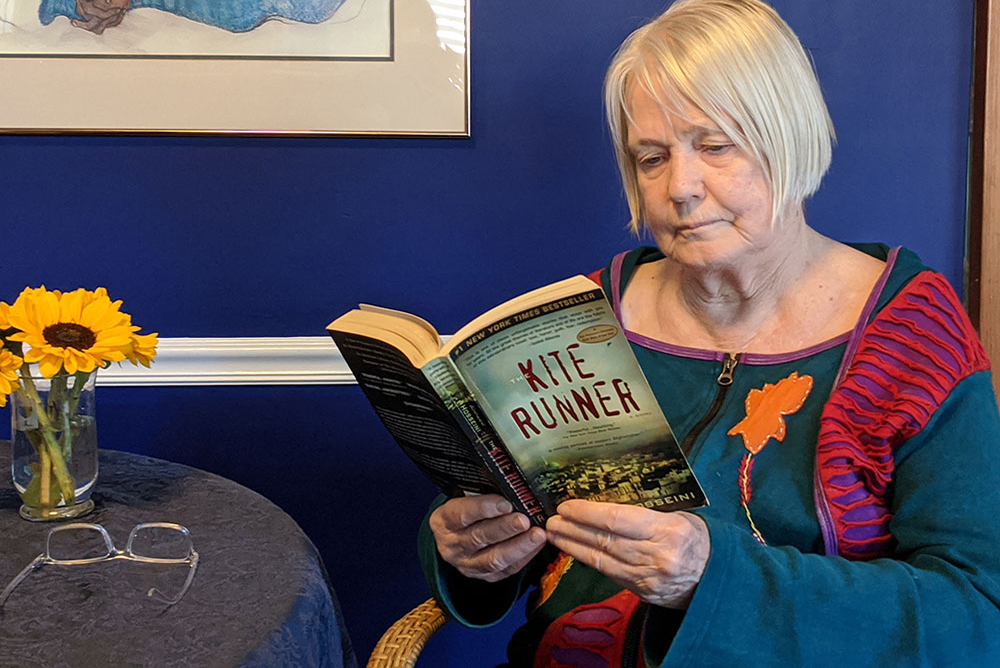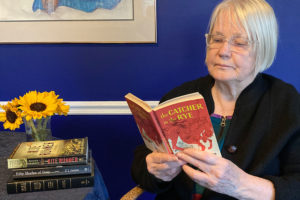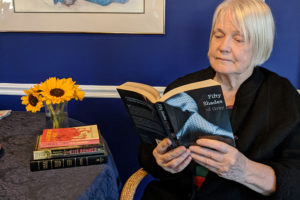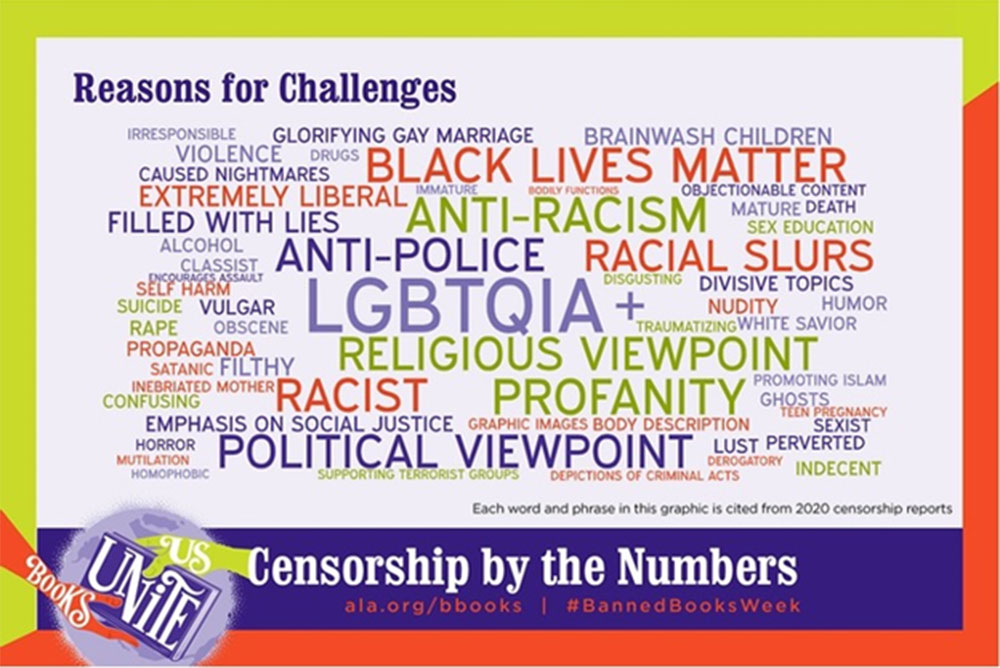
Author Pat McNees loves reading banned or challenged books, including the Holy Bible, on the front. Above, she reads The Kite Runner. / Photos by Susan Pourian.
By Pat McNees
IF YOU THINK you’ve been hearing more about banned books lately, you’re absolutely right. According to the New York Times, the American Library Association (ALA) has reported 330 recent reports of book challenges—more than ever before.
The ALA list of banned and challenged books distinguishes between a “challenge” (an attempt to remove or restrict materials in a classroom or library, based on the objections of one person or group) and actual “banning” (when the material is removed.) You can look up the top 10 books challenged each year (for the years 2000-2020) with the reasons each book was challenged.

Author Pat McNees dips into The Catcher in the Rye. / Photo by Susan Pourian.
Honestly, a look at that list is eye-opening. The reasons given are as interesting as the titles themselves.
For three years running (2018-2020), the No. 1 most often mentioned book was George by Alex Gino, the sensitive portrayal of a transgender child coming to terms with gender identity. It was challenged, banned, and restricted for LGBTQIA+ content, conflicting with a religious viewpoint, and not reflecting “the values of our community.”
♦ No. 5 was The Absolutely True Diary of a Part-Time Indian by Sherman Alexie, banned and challenged for profanity, sexual references, and allegations of sexual misconduct by the author.
♦ To Kill a Mockingbird by Harper Lee (No. 7) was still being both banned and challenged for racial slurs and their negative effect on students, for featuring a “white savior” character, and for its perception of the Black experience.
♦ The No. 10 book in 2019 was a children’s picture book, And Tango Makes Three by Peter Parnell and Justin Richardson, the story of two male penguins at the Central Park Zoo who became inseparable. When zookeepers gave the pair a motherless egg, they successfully hatched baby Tango. This story about a same-sex family was challenged and relocated for LGBTQIA+ content.

Fifty Shades of Grey is one of the challenged books that author Pat McNees seems to be enjoying. / Photo by Susan Pourian.
Most writers can’t stand the idea of limiting access to books. What can you do to counter the pressures librarians and teachers get to remove books from circulation? I’ve been following this issue for years, and here are a few possibilities:
1. Stand up to censorship and participate in the Stand for the Banned Virtual Readout by posting a video of yourself or a kid you know reading from a banned book or talking about censorship. Videos may be featured on the Banned Books Week YouTube channel. Read guidelines here.
2. Report instances of censorship to members of the Banned Books Week Coalition, which includes the American Library Association, the Comic Book Legal Defense Fund, the National Coalition Against Censorship, or the National Council of Teachers of English.
3. Exercise your reading rights. Check out or buy a banned book from the ALA’s list. Encourage your book club to discuss what you read.
4. Pick a Banned Books image from Pinterest and post it online.
5. Help celebrate Banned Books Week (Sept. 18-24, 2022)
6. And follow it on Twitter.
And lastly, don’t despair. As Phyllis Reynolds Naylor points out: “Well, the man who first translated the Bible into English was burned at the stake, and they’ve been at it ever since. Must be all that adultery, murder, and incest. But not to worry. It’s back on the shelves.”


And it is so satisfying to see a book’s sales increase because the book is banned!
I definitely encourage book clubs to select banned books to read, partly to discuss why on earth they were banned in the first place. (Possible selections: The Bluest Eye by Toni Morrison, The Hate U Give by Angie Thomas, The Handmaid’s Tale by Margaret Atwood, To Kill a Mockingbird by Harper Lee, The Kite Runner by Khaled Hosseini. Wouldn’t it be interesting to ask young readers to pick books from the banned books list and decide for themselves if there was a legitimate reason to ban the book. I’d start with Huckleberry Finn by Mark Twain and Brave New World by Aldous Huxley, maybe.
Thank you for shining a light, as someone said, the surest way to get a kid to read a book is to ban it ❤️
Wow! I love this!
The American version of the Taliban is straining – trying to become relevant through their message of hate, intolerance, and baseless bigotry.
You’ve inspired me to form a book club based on love, inclusivity, and nondualistic intelligence. And this list of banned books makes it easier to select books to read!
Xo